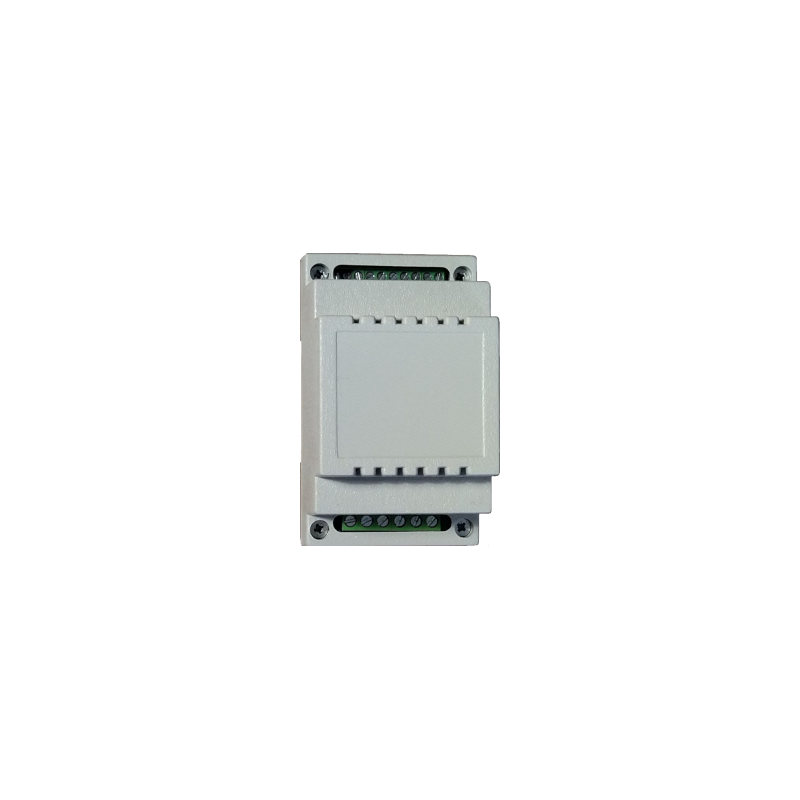

Email: store@creasol.it - Telegram: CreasolTech - Whatsapp: +393283730010
Prioritní pošta: rychle a levně - Expresní kurýr:
Před vrácením produktů nás kontaktujte!

DomBus34 je aModul DIN-RAIL, šířka 54 mm,navrženo krozhraní až 4 měřiče výkonu/energie, typ DDS 238-2 ZN/S (Modbus), na míruvýkon a energie (dovážené i vyvážené), frekvence napětí a účiník.
Realizuje2 reléové výstupy250V 5A SPST s přepěťovou ochranou,1 AC vstup110-240 Vac, a2 nízkonapěťové vstupykteré lze připojit k tlačítkům a spínačům, dvojitým tlačítkům a čítačům.
 Plná podpora: většinu produktů navrhujeme my!
Plná podpora: většinu produktů navrhujeme my!
Email: store@creasol.it - Telegram: CreasolTech - Whatsapp: +393283730010
 Objednávky jsou odesílány do 1 pracovního dne
Objednávky jsou odesílány do 1 pracovního dne
Prioritní pošta: rychle a levně - Expresní kurýr:
 Záruka 24 měsíců, snadné vrácení / vrácení peněz
Záruka 24 měsíců, snadné vrácení / vrácení peněz
Před vrácením produktů nás kontaktujte!
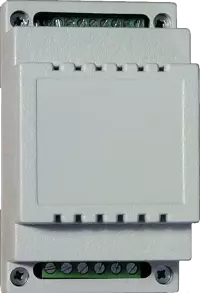 DomBus34 je aModul DIN-RAIL, šířka 54 mm,navrženo krozhraní až 4 měřiče výkonu/energie, typ DDS 238-2 ZN/S (Modbus), na míruvýkon a energie (dovážené i vyvážené), frekvence napětí a účiník.
DomBus34 je aModul DIN-RAIL, šířka 54 mm,navrženo krozhraní až 4 měřiče výkonu/energie, typ DDS 238-2 ZN/S (Modbus), na míruvýkon a energie (dovážené i vyvážené), frekvence napětí a účiník.
Realizuje2 reléové výstupy250V 5A SPST s přepěťovou ochranou,1 AC vstup110-240 Vac, a2 nízkonapěťové vstupykteré lze připojit k tlačítkům a spínačům, dvojitým tlačítkům a čítačům.
Je navržen tak, abyaktivujte zátěže na základě dostupnosti energie, například když vyrábí fotovoltaický nebo větrný systéma dozobrazit pěkné grafy se statistikami o výrobě/spotřebě energies meziročním srovnáním.
Přepínání zátěže lze dosáhnout pomocí příkazů DCMD, ale jak to fungujeDomoticzautomatizace domácnostisystém, je také snadné ho vyrobitvizuální a textové skripty pro provádění i složitých automatizací.
Stejně jako ostatní moduly DomBus,všechny porty lze konfigurovat mnoha různými způsobya také tento modulpodporuje DCMD, příkazy zasílané stejným nebo jiným modulůmprovádět jednoduché akce, které umožňují dosáhnout vysoké spolehlivosti(Příkazy DCMD fungují, i když ovladač domotic není funkční) a snadné programování (nemusíte vytvářet automatizaci v řadiči domotic, stačí nakonfigurovat porty DomBus pro provádění akcí na událostech). V neposlední řadě, stejně jako ostatní moduly DomBus, je to <silný>optimalizované pro dosažení nízké spotřeby energie, méně než 10 mW normálně (0,75 mA @ 13,6 V) a méně než 150 mW, když jsou všechna relé zapnutá (10 mA @ 13,6 V).
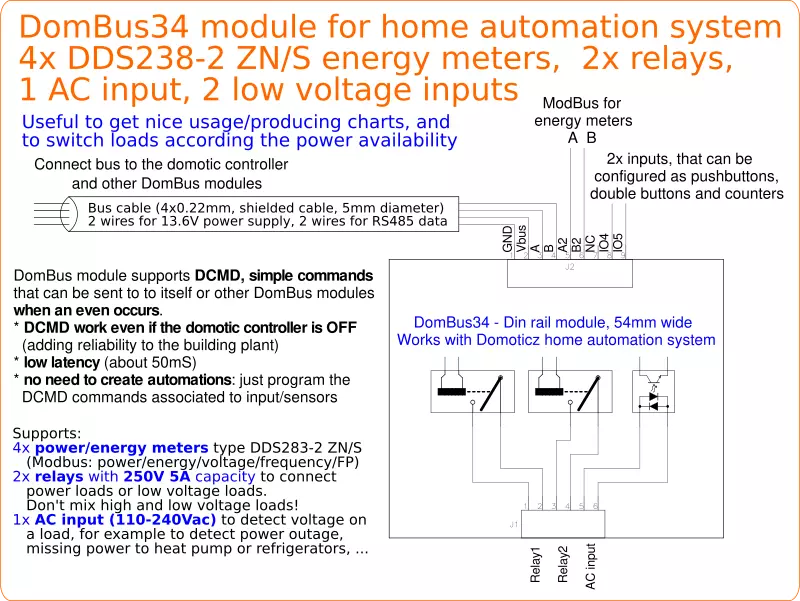
Elektroměry DDS238-2 ZN/S jsou z výroby naprogramovány s adresou Modbus = 1. Pokaždé, když je k Modbus připojen nový elektroměr, jeho výchozí adresa by se měla změnit na 2, 3, 4 nebo 5, výběrem zařízeníM1 adra zápis do zařízení Popis ADDR=2, například: tímto způsobem bude elektroměr s Modbus addr=1 naprogramován s nově zvolenou adresou.
Kdykoli je přidán nový elektroměr, bude povolena nová sada zařízení, která zobrazuje aktuální import a export výkonu/energie, napětí, účiníku a frekvence.
* Zkontrolujte prosím stránku v angličtině, abyste získali správné hodnoty příkazů!
I když je možné provádět jakoukoli automatizaci pomocí funkcí ovladače domotic,základní automatizace lze provádět pomocí příkazů DCMD, které jsou spouštěny přímo modulem DomBus. Příkazy DCMD by měly být uvedeny v popisu zařízení,fungovat i v případě, že je ovladač domotic offline a lze jej odeslat do stejného modulu samotného nebo do jiných modulů DomBuspřipojený na stejnou sběrnici.
Syntaxe jeDCMD(Událost:Nízká hodnota:ValueVysoká)=Adresa modulu.Port modulu:Příkaz:Hodnota
kde ValueLow, ValueHigh, Value jsou volitelné parametry.
<tr>VYPNUTOK tomu dochází i tehdy, když se vstup (IO1, IO2 nebo INAC) vypne
DCMD(OFF)=3401.1:OFF Když se vstup vypne, vypne také port 1 modulu 3401
DCMD(OFF)=3102.1:OFF Když se vstup vypne, vypne také port 1 modulu 3102
| událost | Popis | Příklad |
| NA | K tomu dochází i tehdy, když se vstup (IO1, IO2 nebo INAC) zapne |
DCMD(ON)=3401.1:ON:90s Když se vstup zapne, zapne port 1 modulu 3401 na 90s DCMD(ON)=3102.1:ON Když se vstup zapne, zapne port 1 modulu 3102 |
| PULS | Vstup je pulzně zapnutý po dobu kratší než 0,5 s | DCMD(puls)=13,3:PŘEPNUTÍ Když je vstup krátce pulsován, pošlete příkaz do portu 3 modulu 13 pro přepnutí výstupu na OFF->ON nebo naopak |
| PULZ1 | Vstup je pulzně zapnutý po dobu asi 1s |
DCMD(pulz1)=13,3:ON |
| PULZ 2 | Vstup je pulzně zapnutý asi 2 s |
DCMD(Puls2)=13,3:OFF |
| PULZ 4 | Vstup je pulzně zapnutý asi 4 s |
DCMD(Pulse4)=13,4:ON:2h |
| HODNOTA | Hodnota senzoru je ≥ ValueLow a < ValueHigh Příkaz se opakuje každých 30 s, pokud se porovnání shoduje. |
DCMD(Hodnota:0:100)=31,8:OFF DCMD(Hodnota:0:248)=34,2:OFF |
Za předpokladu, že modul DomBus34 má adresu 3401, vyberete zařízení Grid Import Energy a zapíšete do pole popisu
DCMD(hodnota:1800:65000)=3401,1:ON
je možné nakonfigurovat zařízení tak, aby automaticky aktivovalo relé1, když je exportní výkon větší nebo roven 1800W ( například pro aktivaci kotle nebo jiné zátěže ).
Zapsáním následujícího příkazu do mřížky Import energie
DCMD(hodnota:500:65000)=3401,1:OFF,
modul DomBus34 bude nakonfigurován tak, aby deaktivoval relé1, když je importovaný výkon větší než 500W . Toto chování je řízeno interně modulem DomBus34 a regulátor domotic bude informován o stavu výstupu Relay1.
Podobně zápis následujících příkazů do zařízení Grid Voltage
DCMD(Hodnota:252:280)=3401,2:ON, DCMD(Hodnota:0:248)=3401,2:OFF
je možné aktivovat relé2 výstup, když napětí vzroste na 252V nebo více, deaktivovat relé2, když napětí klesne pod 248V: to může být užitečné během léta, aby se zabránilo odpojení měniče (přepěťová ochrana) povolením zátěže nebo odpojením fotovoltaického řetězce.
Pokud je výstup pro aktivaci/deaktivaci v jiném modulu DomBus, stačí zadat jeho adresu(např. 0001.8)a tento výstup bude povolen/deaktivován na základě aktuální hodnoty výkonu nebo napětí.
The following video shows a presentation of some domotic modules designed and produced in Italy by Creasol to make a reliable, easy and power-optimized home automation system.
The next video shows our Smart EVSE module that can be used to charge the electric car by using only solar power, or adding 25/50/75/100% of available power from the electrical grid.
Our industrial and home automation modules are designed to be
Modules are available in two version:
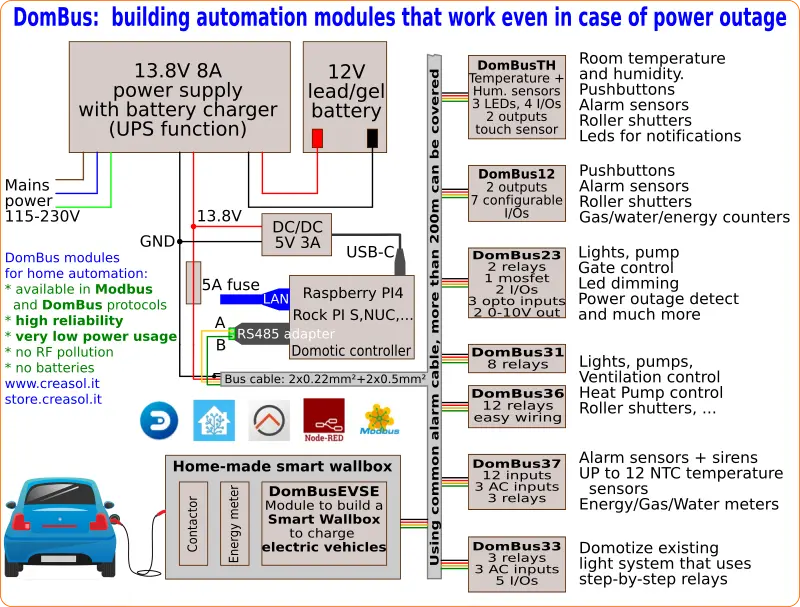
Store website - Information website
For our products we can offer FULL SUPPORT and CUSTOMIZATION: please contact us by Email or Telegram
 Complete solution to make a Smart EVSE, charging the electric vehicle using only energy from renewable source (photovoltaic, wind, ...), or adding 25-50-75-100% of available power from the grid.
Complete solution to make a Smart EVSE, charging the electric vehicle using only energy from renewable source (photovoltaic, wind, ...), or adding 25-50-75-100% of available power from the grid.
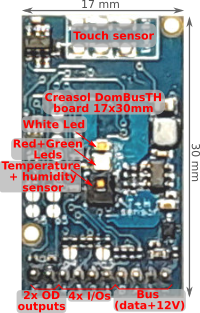 Compact board, 32x17mm, to be installed on blank cover with a 4mm hole in the middle, to exchange air for the relative humidity sensor. It can be installed in every room to monitor temperature and humidity, check alarm sensors, control blind motor UP/DOWN, send notifications (using red and green leds) and activate white led in case of power outage.
Compact board, 32x17mm, to be installed on blank cover with a 4mm hole in the middle, to exchange air for the relative humidity sensor. It can be installed in every room to monitor temperature and humidity, check alarm sensors, control blind motor UP/DOWN, send notifications (using red and green leds) and activate white led in case of power outage.
Includes:
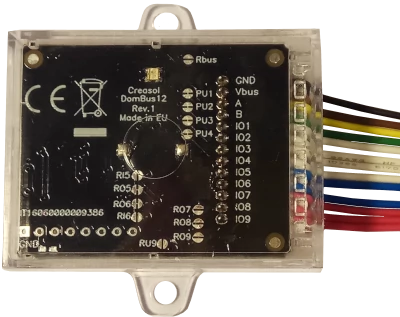 Very compact, versatile and cost-effective module with 9 ports. Each port can be configured by software as:
Very compact, versatile and cost-effective module with 9 ports. Each port can be configured by software as:
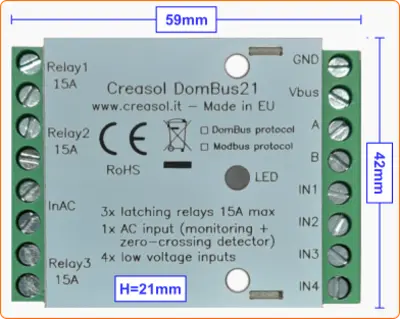 Very low power consumption module designed to enable up to 3 high power loads, up to 15A (3kW).
Very low power consumption module designed to enable up to 3 high power loads, up to 15A (3kW).
 Versatile module designed to control gate or garage door.
Versatile module designed to control gate or garage door.
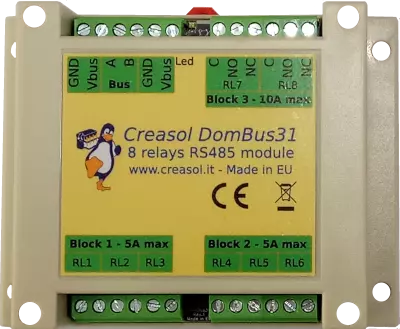 DIN rail low profile module, with 8 relays and very low power consumption:
DIN rail low profile module, with 8 relays and very low power consumption:
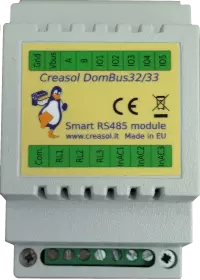 Versatile module with 230V inputs and outputs, and 5 low voltage I/Os.
Versatile module with 230V inputs and outputs, and 5 low voltage I/Os.
 Module designed to control 3 lights already existing and actually controlled by 230V pushbuttons and step-by-step relays. In this way each light can be activated by existing pushbuttons, and by the domotic controller.
Module designed to control 3 lights already existing and actually controlled by 230V pushbuttons and step-by-step relays. In this way each light can be activated by existing pushbuttons, and by the domotic controller.
Each relay can toggle the existing step-relay, switching the light On/Off. The optoisolator monitors the light status. The 5 I/Os can be connected to pushbuttons to activate or deactivate one or all lights.
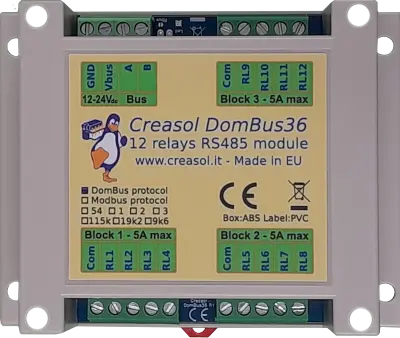 DIN rail module, low profile, with 12 relays outputs and very low power consumption.
DIN rail module, low profile, with 12 relays outputs and very low power consumption.
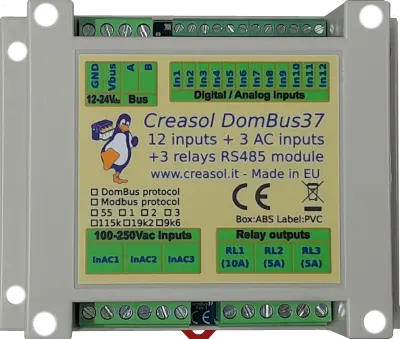 Module designed to be connected to alarm sensors (magnetc contact sensors, PIRs, tampers): it's able to monitor mains power supply (power outage / blackout) and also have 3 relays outputs.
Module designed to be connected to alarm sensors (magnetc contact sensors, PIRs, tampers): it's able to monitor mains power supply (power outage / blackout) and also have 3 relays outputs.
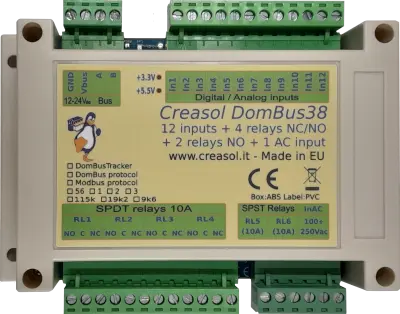 DIN rail module designed for burglar alarm system.
DIN rail module designed for burglar alarm system.
![]() DIN rail module that control azimuth + elevation/tilt motors of a sun tracker, to maximize photovoltaic energy production during the day and seasons.
DIN rail module that control azimuth + elevation/tilt motors of a sun tracker, to maximize photovoltaic energy production during the day and seasons.
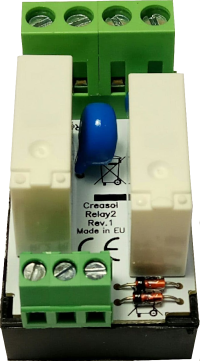 Simple module with 2 relays, to be used with DomBus modules or other electronic boards with open-collector or open-drain outputs
Simple module with 2 relays, to be used with DomBus modules or other electronic boards with open-collector or open-drain outputs
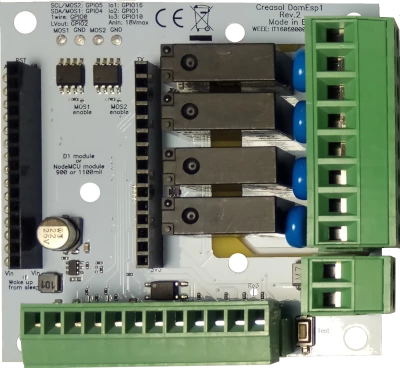 IoT board designed for NodeMCU v3 board using ESP8266 WiFi microcontroller
IoT board designed for NodeMCU v3 board using ESP8266 WiFi microcontroller